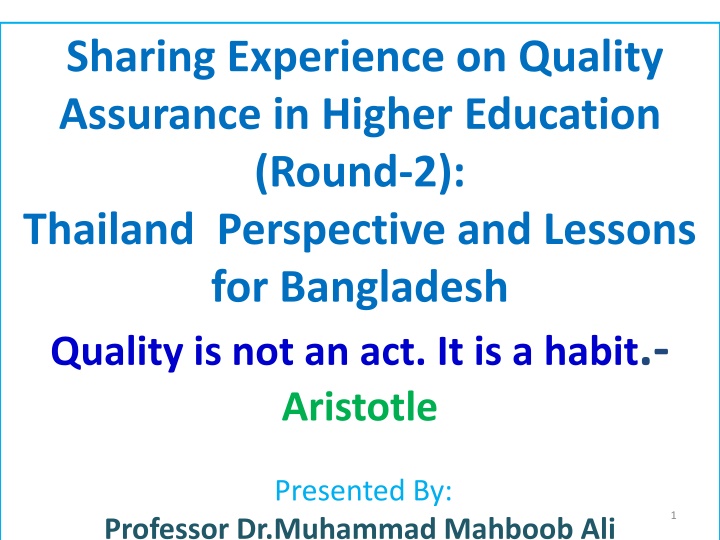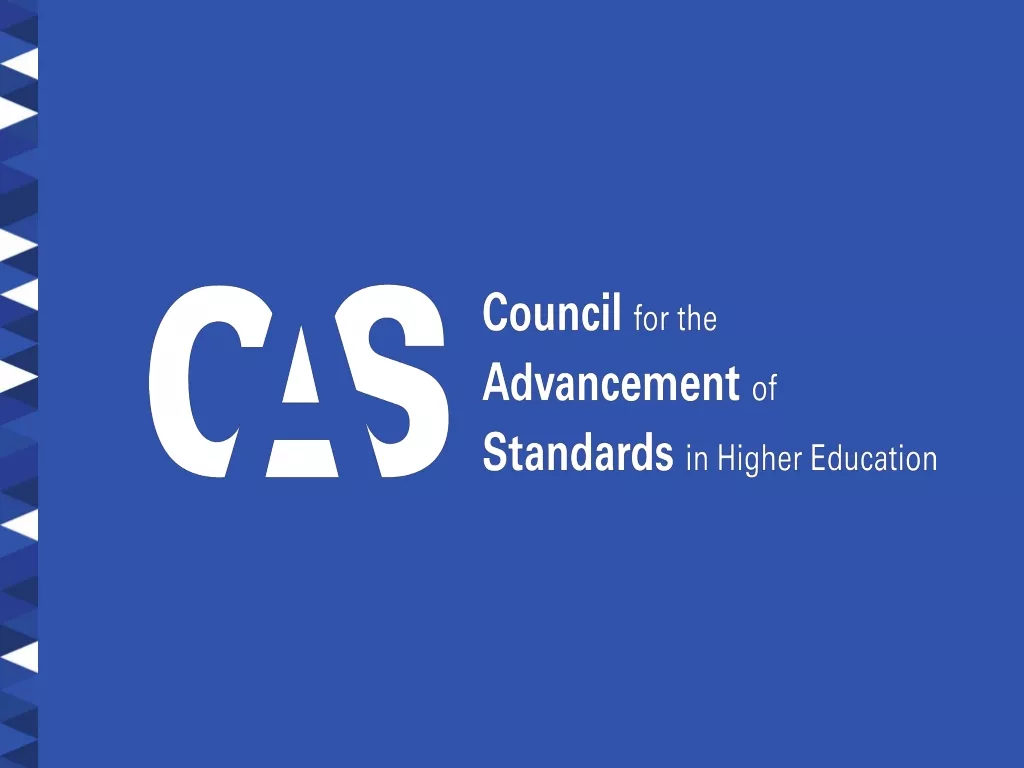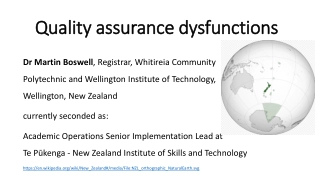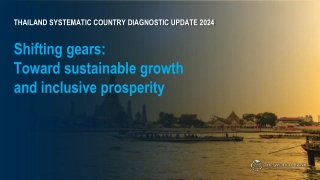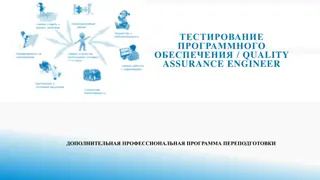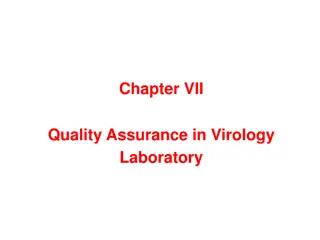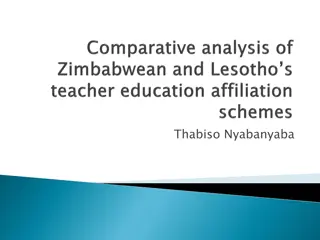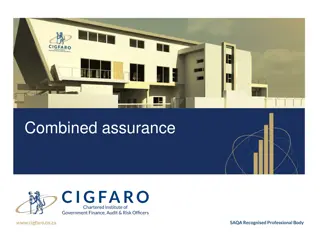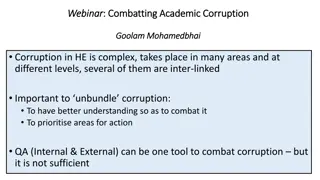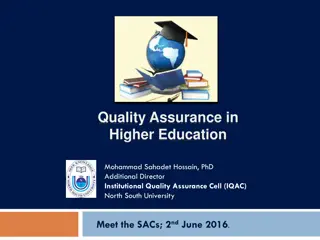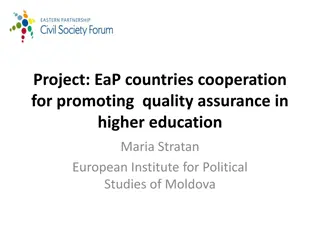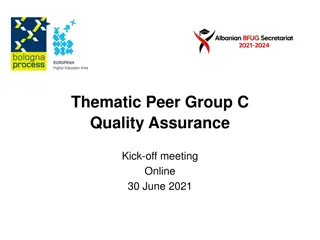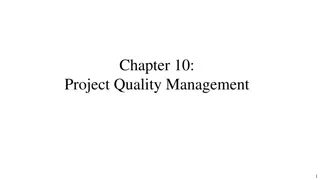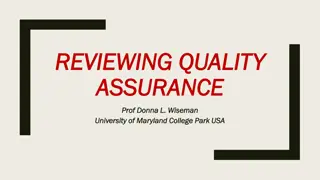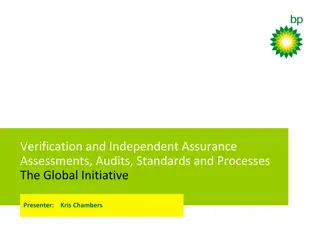Quality Assurance in Higher Education: Thailand Perspective and Lessons for Bangladesh
Explore the insights shared on quality assurance in higher education from a Thai perspective and key takeaways for Bangladesh. Delve into the Thai Qualifications Framework, internal and external quality assessment, and the elements of quality assurance in higher education. Gain a deeper understanding of developing quality education in higher institutions.
Download Presentation

Please find below an Image/Link to download the presentation.
The content on the website is provided AS IS for your information and personal use only. It may not be sold, licensed, or shared on other websites without obtaining consent from the author.If you encounter any issues during the download, it is possible that the publisher has removed the file from their server.
You are allowed to download the files provided on this website for personal or commercial use, subject to the condition that they are used lawfully. All files are the property of their respective owners.
The content on the website is provided AS IS for your information and personal use only. It may not be sold, licensed, or shared on other websites without obtaining consent from the author.
E N D
Presentation Transcript
Sharing Experience on Quality Assurance in Higher Education (Round-2): Thailand Perspective and Lessons for Bangladesh Quality is not an act. It is a habit.- Aristotle Presented By: 1 Professor Dr.Muhammad Mahboob Ali
Acknowledgement Government of Bangladesh Ministry of Education University Grants Commission, Bangladesh World Bank Higher Education Quality Enhancement Project Asian Institute of Technology,Extension,Thailand Prof. Dr. Mesbashuddin Ahmed Prof. Dr. Sanjoy Kumar Adhikary Prof. Dr. M.Abul Kashem 2
Time Period: From 18 to 29 November 2015 at AIT extension , Thailand Total Participants : 18 As an operational activites,15 Directors and Additional Directors of IQAC and 3 officials from QAU,UGC and HEQEP professionally are trained at AIT Extension for 12 days for developing IQA under Round-2 Universities Initials of the Participants name: MMA, QSH,AD,MNI,MA, TPB, MMR, SNA, MTIM, MNI,SMKA,DNRP, AKMA, MMR,MTH,JP,MMH,GCR 3
Prelude Government of Bangladesh set super goal to develop quality education at higher institutions- Vision 2021; 4
Thai Qualifications Framework (TQF) for Higher Education Knowledge Numerical analysis & communication & IT skills Ethics and moral 5 domains of learning outcomes Interpersonal skills & responsibility Cognitive skills 6
Thai Qualifications Framework (TQF) for Higher Education Internal Quality Assessment - Assessors are appointed by the Institutions (Registered by Higher Education Commission) at Thailand. External Quality Assessment - Assessors are appointed by the Office or National Education Standards and Quality Assessment (ONESQA) at Thailand. Quality assurance system at Higher Education: Administrative and procedural activities executed so that requirements and goals for higher education or activity will be properly fulfilled. 7
Elements of QAS in HE Andrea Bernhard: Quality Assurance in an International Higher Education Area 8
Bloom's Taxonomy(NEW VESION): http://ww2.odu.edu/educ/roverbau/Bloom/blooms_t axonomy.htm 9
BANGLADESH PERSPECTIVE Quality Assurance in Higher Education Quality management of Higher Education: Requires attention to every details Input Process Output UGC monitors higher educational institutes. Professional Bodies, International accreditation councils are also working in some higher educational institutes of Bangladesh. 10
IQA at Department Level Criterion 1 Objective and planning Criterion 2 Teaching and learning Criterion 3 Student development Criterion 4 Research and Development Criterion 5 Academic services for social community Criterion 6 Art and cultural support Criterion 7 Administration and management Criterion 8 Quality assurance system WAY= CONTINUOUS IMPROVEMENT DETERMINING FACTOR= DEMAND AND SUPPLY OF THE MARKET END RESULT= EMPLOYABILTY + 11
PDCA Approach to Write Self Assessment Report Act Plan Communicate intent Organize team Develop plan Understand QA criteria & process Finalize SAR Communicate SAR Get ready Check Verify SAR Do Gather feedback Self-assessment Collect data & evidences Close gaps Write SAR Review SAR 12
The indicators for the self-assessment of institutional quality are ( Source: Total Quality Management in Education, Third edition, Edward Sallis): access (5%); services to customers (5%); leadership (15%); physical environment and resources (5%); effective learning and teaching (20%); students (15%); staff (15%); external relations (5%); organization (5%); standards (10%). 13
Quality Assurance of Teaching & Learning Process: Curriculum design, review & approval process , Teacher Quality, Lesson Plan , Research and Extension, Quality of assurance of assessments/ examinations, stakeholders inputs, examiners, students feedback should be taken into cognizance; Support Staff Quality :Number, type and qualification of support staff, career plan, training plan, appraisal system, award & recognition schemes, student/faculty feedback; Student Quality : Student selection process, trend of student intakes, credit system, student workload, student performance reports; 14
Facilities and Infrastructure :Number and type of facilities, utilization rates, downtime/uptime, maintenance plan, new facilities and upgrading plans, safety & health policy, facilities booking system; Student Advice and Support Mechanisms : to report and feedback on student progress, coaching, mentoring and counseling schemes, student feedback Constructing yearly action plan : at the Institutional, Department and Program level to achieve quality education through arranging a road map to achieve the target; 15
Community Services: Students should be encouraged to do community services as a part of academic need; IT infrastructure: IT infrastructure is the backbone of modern learning system; Library Facilities: Library facilities should be raised for not only serious students but also those who are not serious students at all; 16
Art and cultural support: Art and cultural support for the students as well as faculties ought to be arranged; Cultural heritage of 3000 years may be preserved by the universities. Internationalization: International collaborations , Number of International students, inbound and outbound exchange students ,quality accommodation for international students may be arranged; Focus: Culture , Innovation, Engagement , and Inclusiveness should be given; 17
Journals: University may try to index their journals at Scopus listed or similar type of indexed journal; Citation of the works of the faculties at the Scopus listed journal will beneficial for the university; Industry collaboration : Industry collaboration through consulting and research and extension may be encouraged; 18
Graduate Employment rate : Quality of Graduates must be at par at regional and global arena so that employment rate can be raised ; Self Assessment report: Constructing self- assessment system at the program level , Faculty level and Institutional level; Cyclical Manner : Each Five year , review of quality process within institution in a cyclical manner should be done; 19
Internal and External Quality assurance: Effectiveness of Internal and External Quality assurance system is complementary to each other; National Accreditation Council: Internal review of Quality assurance , external review of quality assurance through forming national accreditation council is required to ensure quality; 20
Recognition: Best Higher Educational Institute may get recognition from the Government each year based on Internal and external evaluation and monitoring report; Best University Teacher of the Country should get National award each year; Researcher whose article will be published and also cited in Scopus indexed journal may get incentives from their institutes. 21
Recommendations: Needs of the country should be identified, indicators should be set up at the institutional level to add value in Global value chain ; National Accreditation Council should be formed . Under BIMSTEC (Bay of Bengal Initiative for Multi- Sectoral Technical and Economic Cooperation) a regional body may develop an educational framework like ASEAN University Network. Sufficient Number of National Assessor for assessing Quality education will have to be appointed; 22
At the institutional level quality of Administration and management should be improved; Physical and infrastructural development of Higher educational institutes where underdevelopment prevails , ought to be done without delay; At the institutional level QS ranking audit may be done for improvement; 23
THANK YOU 24
References: Study materials provided by AIT Extension during the Training program were used. 25
